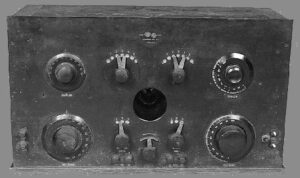Hi all,
A group of former students from Texas A&M University and the University of Texas, loosely known as the Dinosaur Valley DX Society (DVDXS), has put together an 8-day operating event to celebrate the 100th Anniversary of the Nov 24, 1921 Broadcast of the University of Texas and Texas A&M University Football Game via Amateur Radio.
The play-by-play of the football game on Thanksgiving, 1921, between the Longhorns of the University of Texas and the Aggies of the then known Agricultural and Mechanical College of Texas, was arguably the first football game ever broadcast over the air. The game, at Kyle Field in College Station, was broadcast via spark gap transmitter from College Station to a station at the University of Texas, a WWI temporary building on 24th Street, just west of University Avenue. The play-by-play action was transcribed into a set of abbreviations so as to keep up with the game. The transmissions from College Station were received in Austin where the messages were decoded and announced over a horn speaker through an open window to the many interested University students who had gathered outside.

To celebrate this historic achievement, members from the DVDXS have reserved two 1×1 callsigns, N5B and N5U, that will be on the air between the 19th and 26th of November. N5B is similar to the 1921-issued Texas A&M callsign of 5XB; N5U is similar to the 1921-issued University of Texas callsign of 5XU. More detailed information about the actual broadcast and the event may be found on the qrz.com pages of N5B or N5U.
The DVDXS is pleased to invite members from the TAMU ARC, the UT ARC, as well as radio amateur students, alumni and friends of both universities to sign-up to operate “their respective callsign” during the event. The respective sign-up schedules may be found here:
N5U: sign up here
N5B: sign up here
A few simple rules for the operators of these 1×1 callsigns:
- Reserve as many 1-hr time slots as you will operate. The links will be active the whole period, so you can check at any time to see if there’s a slot convenient to your schedule. However, please be courteous and operate the time slots you have reserved; you may cancel reserved time slots via the above links if your plans change; doing so may allow another operator to activate that time slot.
- Within each time slot, you may operate which ever band and mode within the privileges of your license class. Due to the popularity of 1×1 callsigns, suggested modes are SSB, CW and FT8.
- Particularly on SSB, or CW, you might have a brief description prepared of the Special Event (e.g. the title of this announcement and maybe the description contained in the 2 nd paragraph)to share with some of the stations that contact you or following a CQ, such as “CQ CQ from Special Event Station N5B, celebrating the 100th anniversary of the 1921 play-by-play broadcast of the Univ of Texas against Texas A&M Univ Football Game via amateur radio” and refer them to the qrz.com pages.
- Some stations that contact you may want to chit-chat, others will want to make contact with an RST exchange only (contest-style). How you choose to handle each QSO is up to you, but a little bit on conversing is encouraged to get the word out to others that might be listening and waiting to contact you.
- Many hams like to work Special Event Stations. To help increase your contact activity, you might “self-spot” your 1×1 callsign on one of the DX spotting networks. www.dxwatch.com is the easiest to use; instructions are available if needed. As other hams work you, some will spot you as well. Generally, you might self-spot a couple of times during the hour, but probably not later than 45 minutes after the hour if you’re about the cease operations at the top of the hour.
- Very important: please keep logs of your operating, preferably in a computer aided logging program. Forward your 1×1 station logs in ADIF format to Matt Thomas (W5MT (at) arrl (dot) net). The logs are needed to compile the contacts from all operators as well as for QSL/certificate confirmation to requesting contacts.
Most of all, have fun! If you have any questions, please do not hesitate to email either Matt Thomas (W5MT (at) arrl (dot) net) or Larry Smith (K5XB (at) arrl (dot) net).
73!